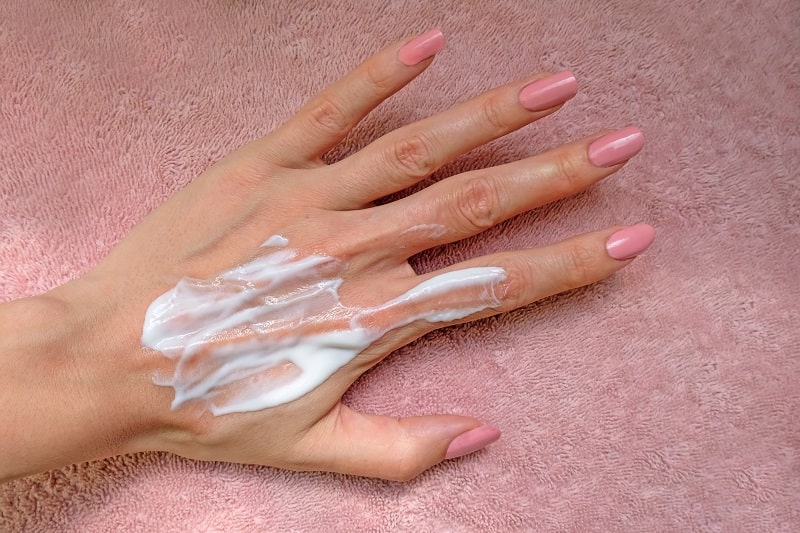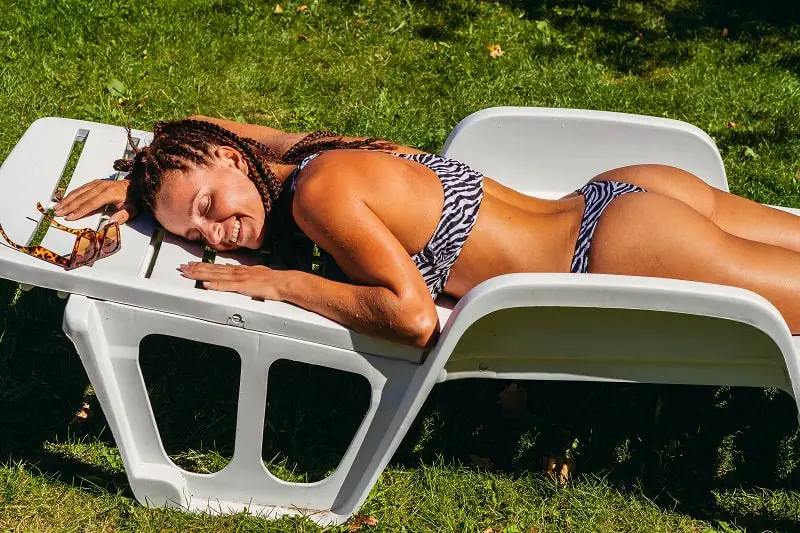Does temperature affect suntanning? Not at all! The temperature outside has no weight when it comes to suntanning, which is why people still get sunburnt when it is overcast out.
Since the outside ambient temperature does not affect tanning, keep in mind that the real source behind envious natural tans is ultraviolet rays emitted from the sun. Both UVA and UVB have a role in forming melanin.
More than anything, the overall damaging effects of the sun’s radiation are yet another reason why dermatologists recommend full-spectrum sunscreen rated SPF 30 or higher, which protects against both types of rays—not just one.
If you are interested in more information about how the temperature outside may (or may not) affect your tanning outcome and what to do if you find yourself tanning in some chilly conditions, feel free to continue reading below.
Does Temperature Affect Tanning?
What comes next may surprise you, but the temperature does not affect tanning. Whether in the height of summer or the dead of winter, the temperature will not encourage or discourage a tan. Generally, tans are formed when the skin is exposed to ultraviolet rays, which trigger skin cells to produce melanin.
Melanin is produced as a reaction to help the body fight skin damage. As they are, melanocytes are kicked into action when UVA penetrates the deeper levels of the skin and causes skin damage; melanin is created to help guard the cells against further damage.
Further evidence against outside temperature affecting the ways a person can get tanned can be found in the innumerable amount of people that experience sunburns in cold weather. For example, those familiar with snowy regions can attest that even in freezing temperatures, sunburn is possible.
You can even achieve a tan if you are brave enough. In this case, the snow reflects and amplifies UV radiation. Further on this topic, cloud cover is irrelevant for tanning. Cloud coverage has little ability to filter the ultraviolet rays from the sun, thus still allowing the option to tan on a dreary day.
However, since it is still possible, one should always wear sunblock when outside, no matter the temperature or weather conditions. Unfortunately, a bit of cloud and a bit of a chill won’t stop UVA and UVB rays from causing skin damage.
Can You Tan In Cold Sunny Weather?
Yes, it is entirely possible to tan in cold, sunny weather. Honestly, you can even tan in cold, overcast weather. Although, one may have to question why you would want to tan in the cold. Just thinking of laying out in the cold in a swimsuit makes me want to snuggle up in a blanket!
Major props to whoever is brave enough to tough out wind chill for a golden glow. On that note, some believe that tanning in colder seasons instead of hotter ones is more beneficial. The reasoning has to do with the UV not being as harsh as during the summer.
However, in the chance that cloud enhancement can occur, I would recommend against trying to get a tan without proper sunscreen regardless of whether or not the ultraviolet radiation is being minimally filtered by coverage.
Do You Tan Quicker If It’s Hotter?
No, you will not necessarily tan quicker if it is hotter outside. The outside temperature is merely a reflection of active wind currents and the amount of cloud cover; it is entirely subject to change, although what remains is the ability for ultraviolet rays to seep through clouds.
Your tan and the speed you tan are wholly determined by the amount of access ultraviolet radiation has to your skin. But, of course, you can expect to tan—and burn—faster if you are fully exposed to UVA and UVB without proper protection.
As stated previously, the outside ambient temperature has no effect during the tanning process. If anything, the temperature only determines how comfortable you will be while laying out. Also, as you can probably imagine, laying out in the warm sun is perhaps far more enjoyable than laying out in any other weather condition.
Stick to whatever temperature you agree with more, and take your time tanning. Always wear sunscreen or a tanner with a Sun Protection Factor of at least 30 whenever outdoors. The sun’s rays can be very dangerous on unprotected skin, resulting in sunburn and even skin cancer.
What Is A Good Temperature For Tanning?
According to an Atlantic article from 2014, 90° F is the ideal temperature for tanning. As the report says, it is “total, complete warmness,” and it has nothing to do with the effects on your tan. That’s right: a good temperature for tanning is all about comfort. With that in mind, find what temperature is most comfortable for you!
And if it changes, that’s okay! The temperature outside can change with the wind—literally. A mild 80° F can feel great until a biting breeze blows by. Likewise, a windless day could be unbearable. Test out the temperature on the day you want to tan or look up the forecast the week of, and plan accordingly!
Final Thoughts: Does Temperature Affect Suntanning?
The most significant takeaway from this article is that the temperature outside has absolutely no effect on tanning or burning. Instead, ultraviolet radiation from the sun causes enough damage to your skin cells to provoke melanocytes into producing melanin.
The production of melanin creates a tan and, since temperature does not trigger melanocytes, the temperature has no hand in tanning. Continuing off of this idea, even cold and cloudy days can result in a tan as UV rays or only minorly filtered; in some instances, they are actually enhanced and can result in a sunburn.
Tanning is possible in weather below the point of freezing, just as frequent as it is in the middle of a California summer. More than anything, it is essential that you are comfortable tanning. The experience should be an enjoyable, relaxing one. Finding a tolerable temperature for you to tan in is crucial.
Avoid exposing yourself to temperatures that are too hot or too cold, and be aware of your limits. Lastly, no matter the weather you find yourself tanning in, you should always be prepared for taking appropriate sun protection measures. Remember to bring sun lotion for reapplication and pack a tanner for an enhanced effect!






